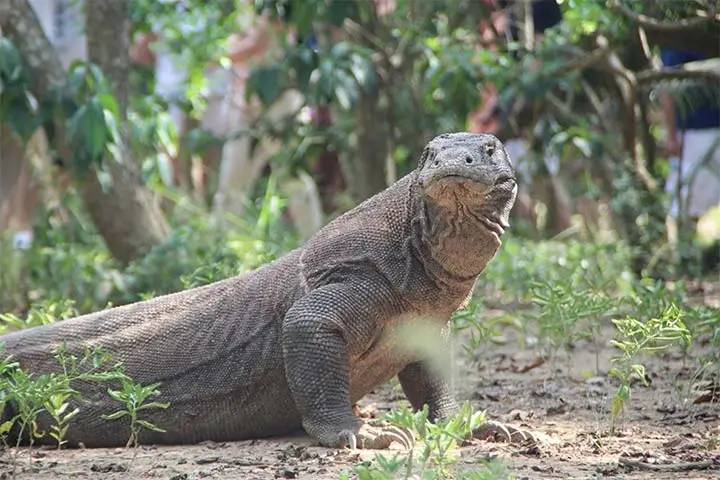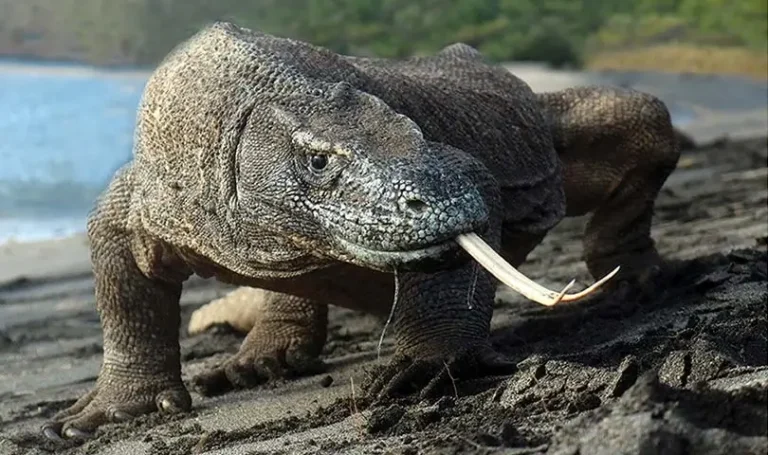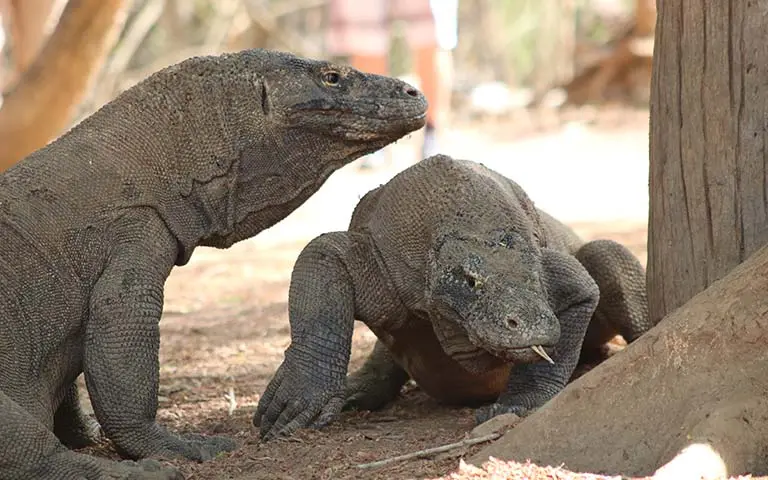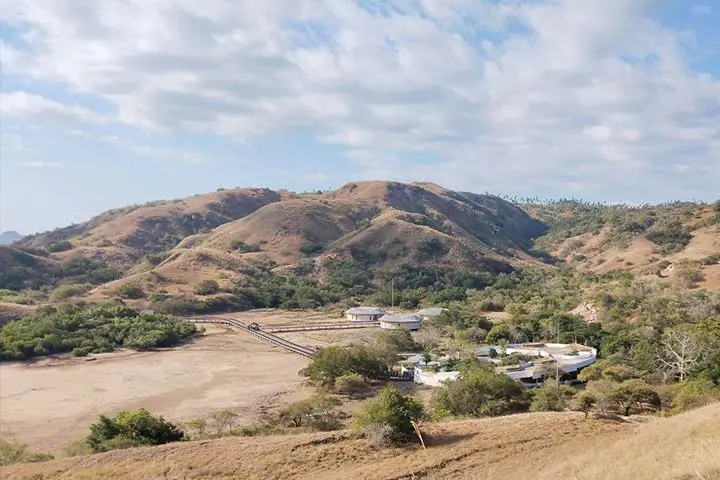Komodo Dragon;
A Largest Living Lizard
on Earth
Top Joyday Tour



Komodo dragon (varanus komodoensis) refers to one of the endangered animal known as largest living lizard on earth. Its natural habitat is in Komodo National Park, an archipelago 500 km east of Bali Island, Indonesia. This prehistoric reptile is still alive in these Islands.
Visitors can find and see this animal in two different islands; Rinca and Komodo Island. Although Komodo dragons are living in several islands beside these two islands such as in Nusa Kode and Gili Motang, but these area is for conservation areas only. All those islands are still a part of a National Park of Komodo.
Facts about Komodo Dragon you need to know
1. The Largest Lizard
Are you thinking that it is a dragon due to its name? No, it is a kind of lizard, the largest lizard in the world. It can grow up to three meters (10 feet), almost the same as the length of a small car.
Also, they are heavy and weigh an average of up to 154 pounds. However, the weight has also been up to 135 kilograms. This is almost the same as a panda bear.
2. Venomous
Komodo Dragon is popularly known as a venomous and notorious hunting strike. There is a belief that its saliva contains various strains of bacteria to kill its targets.
However, the University of Queensland discredited this theory. Now, the belief is that they are similar to snakes which secrete venom proteins.
3. They have their Island
The animal only exists on five islands in Indonesia. There are none of them in other countries in the world except in the islands of the Komodo National Park.
The primary island, as the habitat of the largest amount of this animal in the world, has the same name as these lizards. It is called Komodo Island.
5. Possibly have Originated in Australia
6. A Great Sense of Smells
7. The Same Length of Their Bodies and Tails
8. Carnivores
The Komodo Dragon is among the most ruthless carnivores. It is easy for them to eat any meat, whether it is humans, water buffalo, or large deer. This is the use of their venom and strength.
A surprising fact is that they can eat each other. The younger and smaller can be eaten by the larger lizards.
9. The Ability to Swim
They also can swim since they aren’t good enough adapted to the strong venom and tails as well as the large bodies. They swim just like Dory and have been spotted swimming in the five islands where they live.
They swim easily between the five islands. Additionally, their ability to run is also incredible. Their speed can reach 19 km/hour (12 miles per hour).
Research history of Komodo Dragon
This largest living species of lizard, has long fascinated scientists and the public alike. Native to a few Indonesian islands, including Komodo, Rinca, Gili Motang, and Padar. These formidable reptiles have a fearsome reputation and an intriguing biology that drew the attention of researchers early on
Early Discovery of komodo Dragon
The first documented encounter with the Komodo dragon by scientists dates back to 1910. Lieutenant van Steyn van Hensbroek of the Dutch colonial administration was serving on the Island of Flores, Eastern Indonesia received news from the local people that there was a mysterious lizard living on the island of Komodo.
Then he went to the island to see what was being reported. Then he made a report to the Zoological Museum Bogor. His report piqued the curiosity of Major Peter Ouwens, the director of the Zoological Museum at Bogor (then Buitenzorg), in West Java.
Ouwens' Research
Ouwens’ research provided the first detailed description of the Komodo dragon’s physical characteristics, behavior, and habitat. He noted the dragon’s impressive size, with some individuals exceeding three meters in length, and its robust build. Ouwens also described the dragon’s serrated teeth, powerful jaws, and muscular tail, all of which make it a formidable predator.
Ouwens’ observations highlighted the Komodo dragon’s carnivorous diet, consisting mainly of deer, wild boar, and even water buffalo. He noted their scavenging behavior and remarkable ability to detect carrion from great distances. His research also pointed out the dragons’ preference for hot, arid environments, such as savannas and monsoon forests, which dominate the islands they inhabit
Conservation Efforts
Following his research, numerous expeditions and scientific investigations have been conducted, enhancing our understanding of the species’ biology, ecology, and behavior. Key discoveries have included the Komodo dragon’s venomous bite, its unique reproductive strategies, and its conservation status.
Today, the Komodo dragon is classified as a vulnerable species, facing threats from habitat loss, human activities, and climate change. Conservation efforts, including the establishment of Komodo National Park in 1980, have been critical in protecting the species and its habitat. Ongoing research continues to inform conservation strategies and ensure the survival of these ancient and awe-inspiring reptiles

Local Folklore about Komodo Dragon
Folklore is an oral cultural tradition formed in a particular community. It has become part of Indonesian society. The purpose is a means of entertainment and social culture. These folk tales can provide imaginative experiences while embedding moral values that can be used as examples for society.
It is including the folklore of Komodo dragon that spread among the local communities of Komodo Island.
It is said that, once upon a time there lived a princess named Naga Princess who lived on the island of Komodo. she married a young man from the opposite island named Moja.
long story short, she was pregnant and gave birth to twins, both of them were boys. But unfortunately one of their children has a different body shape that is similar to a lizard. it makes them feel embarrassed. Princess Naga and her Husband Moja named their lizard-like son as Orah and the other was named Gerong.
Because he felt he was different, Orah exiled himself to the forest, meanwhile Gerong was still raised by his parents alone. Gerong grew up and became a dashing man, and was separated from his twin brother.
one day, he went hunting into the Forest. When he arrived in the middle of the forest, he met a giant lizard and was about to throw his spear. Fortunately, at the same time, his mother, Princess Naga, came and forbade Gerong to kill the giant lizard (now known as the Komodo dragon). Then, his mother explained that the giant lizard was his twin brother named Orah who chose to live in the forest.
Since then, the Komodo people have lived side by side with this animal because they consider it as their brother. End of the Story.

Komodo national park: The World of Wonders
Komodo national park is full of natural wonders and adventures. Embarking on a journey into the unknown places, driven by curiosity and guided by the whisper of adventure.

Rangko Cave Tour: One day trip to the hidden Gems salt water cave near Labuan Bajo
Rangko Salt Water Cave tour is a tour that we offer for those who have a free time in Labuan Bajo before heading to their next destination. This cave is near from Labuan Bajo, just about an hours by car. Then, get on the local motorized boat to reach out out the cave.

1D Caci Dance & Countryside Tour
Rangko Salt Water Cave tour is a tour that we offer for those who have a free time in Labuan Bajo before heading to their next destination. This cave is near from Labuan Bajo, just about an hours by car. Then, get on the local motorized boat to reach out out the cave.

Exploring the Wildlife: the Ultimate Herping Tour Experience in Komodo Islands
Caci dance is a traditonal dance belongs to Manggarai tribe. It is and kind of whip fighting dance. The dance is done when special cultural event occurred and on Indonesian independence anniversary.